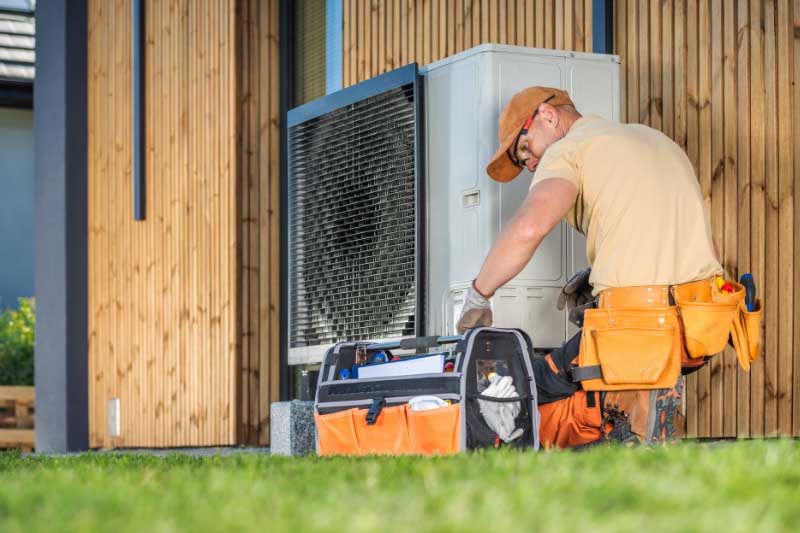Working as an HVAC technician means dealing with electrical systems, heavy equipment, hazardous chemicals, and extreme temperatures daily. While the job offers excellent career prospects and steady income, it also comes with significant safety risks that can’t be ignored.
Every year, thousands of HVAC professionals suffer workplace injuries ranging from minor cuts and burns to serious electrical shocks and falls. Many of these incidents are preventable with proper safety protocols and awareness.
Whether you’re a seasoned professional or just starting your HVAC career, understanding and implementing comprehensive safety measures isn’t just recommended—it’s essential for protecting your health, your livelihood, and your life.
This guide covers the most critical safety practices that every HVAC technician should follow, from the use of personal protective equipment to specific hazard management.
By the end, you’ll have a complete toolkit of safety strategies to help you work confidently and return home safely every day.
23 Important HVAC Safety Tips: A Guide for New Technicians
Discover 23 critical HVAC safety tips every technician must follow to prevent risks and ensure a secure work environment.
Personal Protective Equipment: Your First Line of Defense
Personal protective equipment forms the foundation of HVAC safety. The right PPE can mean the difference between a minor incident and a life-changing injury.
Essential PPE for Every Job
Safety glasses or goggles protect your eyes from debris, chemical splashes, and UV radiation from welding or brazing. Choose wrap-around styles for maximum coverage, and ensure they meet ANSI Z87.1 standards for impact resistance.
Work gloves serve multiple purposes in HVAC work. Insulated gloves protect against electrical hazards, while cut-resistant gloves prevent injuries when handling sharp metal edges. Heat-resistant gloves are crucial when working with hot pipes, furnaces, or soldering equipment.
Steel-toed boots provide essential foot protection from falling tools and heavy equipment. Look for boots with electrical hazard protection and slip-resistant soles to prevent falls on wet or oily surfaces.
Respiratory Protection
HVAC work often involves exposure to dust, fibers, and chemical vapors. A properly fitted N95 respirator handles most dust and particulate matter, while P100 filters protect against asbestos fibers in older buildings.
For chemical exposure, use appropriate cartridge respirators. Refrigerant leaks, cleaning solvents, and other chemicals require specific filter types, so always match your respirator to the hazard you’re facing.
Electrical Safety: Managing Hidden Dangers
Electrical hazards pose some of the greatest risks in HVAC work. From residential wiring to industrial electrical panels, technicians regularly work with live electrical systems that can cause severe injury or death.
Lockout/Tagout Procedures
Before beginning any electrical work, implement proper lockout/tagout procedures. Turn off the power at the circuit breaker, not just at the equipment switch. Use a lockout device to physically prevent the breaker from being turned back on, and attach a tag indicating who performed the lockout and why.
Never assume power is off based on someone else’s word. Always test circuits with a properly calibrated multimeter or voltage tester before beginning work. Test your meter on a known live circuit both before and after checking the work area to ensure it’s functioning correctly.
Working with Live Systems
Sometimes, working on energized equipment becomes necessary for troubleshooting. When this can’t be avoided, follow strict safety protocols. Use insulated tools rated for the voltage you’re working with, and always work in pairs on live electrical systems.
Maintain a safe working distance from energized parts. For systems under 600 volts, maintain a distance of at least 3 feet from exposed conductors unless you’re specifically trained and equipped for closer work.
Chemical and Refrigerant Safety
HVAC technicians regularly handle refrigerants, cleaning chemicals, and other hazardous substances that require careful management to prevent health problems and environmental damage.
Refrigerant Handling
Modern refrigerants, such as R-410A, and older ones, like R-22, can cause frostbite on contact and displace oxygen in enclosed spaces. Always wear safety glasses and insulated gloves when handling refrigerants, and ensure adequate ventilation in work areas.
Store refrigerant cylinders upright and secure them to prevent them from tipping over and falling. Never expose cylinders to excessive heat or flame, as this can cause dangerous pressure buildup and potential explosion.
Chemical Storage and Use
Many HVAC chemicals are corrosive, toxic, or flammable. Read the safety data sheets for every chemical you use, and follow the manufacturer’s recommendations for storage, handling, and disposal.
Keep incompatible chemicals separated to prevent dangerous reactions. Strong acids and bases, for example, should never be stored together. Use appropriate containers and ensure all chemicals are properly labeled.
Fall Prevention and Ladder Safety
Falls represent one of the leading causes of injury in HVAC work. Whether you’re accessing rooftop units, working in attics, or installing equipment at high levels, proper fall protection saves lives.
Ladder Selection and Setup
Select the appropriate ladder for each task. Step ladders are well-suited for accessing equipment at moderate heights, while extension ladders are better suited for reaching rooftops or high wall-mounted units.
Set up ladders on firm, level ground, and maintain the proper angle. The base should be one foot away from the wall for every four feet of ladder height. Always maintain three points of contact when climbing, and never overreach to avoid tipping.
Working at Height
For work above six feet, consider using fall protection systems, such as safety harnesses and lanyards. Secure attachment points must support at least 5,000 pounds per person attached.
When working on rooftops, be aware of the roof’s condition. Wet, icy, or damaged roofing materials create additional slip hazards. Use roof anchors or guardrail systems when possible, and avoid working near roof edges.
Equipment and Tool Safety
HVAC tools and equipment, ranging from basic hand tools to specialized machinery such as refrigerant recovery units, require proper handling to prevent injury.
Hand Tool Maintenance
Keep tools in good condition by regularly inspecting and maintaining them. Damaged tools are more likely to slip, break, or cause injury. Replace worn cutting tools, and ensure all electrical tools have intact cords and proper grounding.
Use tools only for their intended purpose. A wrench isn’t a hammer, and pliers aren’t meant for heavy prying. Using tools incorrectly increases the risk of injury and damages equipment.
Power Tool Precautions
Inspect power tools before each use, checking for damaged cords, loose guards, and proper operation. Use ground fault circuit interrupters when working in wet conditions or on metal surfaces that could conduct electricity.
Keep cutting tools sharp and properly guarded. Dull blades require more force and are more likely to bind or slip. Always let rotating tools come to a complete stop before setting them down.
Work Environment Awareness
HVAC technicians work in diverse environments, from cramped crawl spaces to busy industrial facilities. Each location presents unique hazards requiring specific safety considerations.
Confined Space Safety
Many HVAC installations are located in confined spaces, such as mechanical rooms, crawl spaces, or underground vaults. These areas may have limited ventilation, awkward access, or atmospheric hazards.
Before entering confined spaces, test the atmosphere for oxygen levels, flammable gases, and toxic vapors. Ensure adequate ventilation, and have a safety observer outside the space who can summon help if needed.
Weather Considerations
Outdoor work exposes technicians to weather-related hazards. Hot weather increases the risk of heat exhaustion and dehydration, while cold conditions can cause frostbite and reduce manual dexterity.
Take frequent breaks in extreme temperatures, stay hydrated, and dress appropriately for conditions. In winter, be aware that metal surfaces become extremely cold and can cause skin to stick on contact.
Emergency Preparedness and First Aid
Despite the best safety practices, accidents can still occur. Being prepared to respond quickly and appropriately can minimize the severity of injuries and potentially save lives.
First Aid Basics
Every HVAC technician should be familiar with basic first aid, including how to treat cuts, burns, and electrical shock. Keep a well-stocked first aid kit easily accessible, and be familiar with the location of emergency equipment, such as eyewash stations and emergency showers.
For electrical shock victims, never touch them directly if they’re still in contact with the electrical source. Use a non-conductive object to separate them from the power source, then check for breathing and pulse.
Emergency Communication
Always carry a charged cell phone or two-way radio for emergency communication. When working alone, establish check-in procedures with your supervisor or dispatcher.
Be familiar with the addresses of your work locations and the quickest routes for emergency vehicles. This information can be crucial when calling for help in an emergency.
Ongoing Safety Education
Attend regular safety meetings and training sessions offered by your employer or trade organizations. Many manufacturers also provide safety training tailored to their specific equipment.
Stay informed about regulatory changes from OSHA, EPA, and other agencies that affect HVAC work. These organizations regularly update safety standards and requirements.
Mentoring and Knowledge Sharing
Experienced technicians should share safety knowledge with newer workers. Create a culture where safety discussions are welcome and near-miss incidents are reported and analyzed for learning opportunities.
Don’t hesitate to speak up if you observe unsafe practices. Ensuring coworkers’ safety is everyone’s responsibility, regardless of seniority or position.
Building a Safety-First Career
HVAC work doesn’t have to be dangerous when proper safety measures are consistently applied. The techniques and practices outlined in this guide form the foundation for a safe and successful career in the HVAC industry.
Remember that safety isn’t just about following rules—it’s about protecting your ability to provide for yourself and your family throughout a long, healthy career. Every shortcut you skip and every safety protocol you follow is an investment in your future.
Start implementing these safety practices immediately, and make them non-negotiable parts of your work routine. Your commitment to safety will not only protect you but also set a positive example for others in the industry. Most importantly, it ensures you can continue doing the work you love while returning home safely to the people who matter most.





